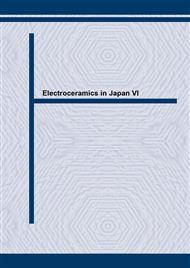[1]
T. Nomura,S. Sumita,Y. Nakano,K. Nishiyama, Proc. 5thUS-l. japan Seminar on Dielectric and Piezoelectric Ceramics, (1990) 29-32.
Google Scholar
[2]
R. Waser,T. Baiatu and K. Hardtl, J. Am. Ceram. Soc., 3 (1990) 1645-1653.
Google Scholar
[3]
N. Fujikawa, NipponCeramiics Kyokai Denshizairyou-bukai, (1990) 86.
Google Scholar
[4]
H. Kabasawa,H. Saitoh, S. Tosaka, NEEDS&SEEDS, 10(1994)15-18.
Google Scholar
[5]
W. Carlson,T. Rutt,M. Wild, Ferroelectric Letters, 21(1996)1-9.
Google Scholar
[6]
H. Chazono, Y. Inomata, N. Kohzu and H. Kishi 㧦Key Engineering Materials Vols. 169-170(1999)31-34 e-mail: yukien@mb1. tdk. co. jp.
Google Scholar
[11]
0 0 50 100 150 Temp. [C] �[uF] 0MPa 5MPa 25MPa 50MPa 100MPa 150MPa Thickness direction Fig. 7(a) Effect of the external stress in thickness direction on the temperature dependence of capacitance. 7. 0.
Google Scholar
[11]
0 0 50 100 150 Temp. [C] �[uF] 0MPa 5MPa 18MPa 41MPa 100MPa 182MPa Width direction Fig. 7( � ) Effect of the external stress in width direction on the temperature dependence of capacitance. -10 -8 -6 -4 -2 0 2 4.
Google Scholar
01 0. 1 1 10 100 dc-bias[V] �apacitance change [%] 10 layers 50 layers 200 layers Fig. 8 Effect of dc-bias on capacitance change of MLCCs with various numbers of layers.
Google Scholar


